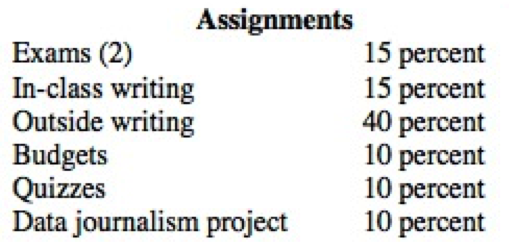Decoding Your Syllabus
On the first day of classes, professors hand out and go over the syllabus. Everything you need to know about the course is in it. The syllabus includes the professors contact information, course objectives, the assignments and materials, how you will be graded and whatever else the professor deems important. Some university polices, like academic dishonesty and disabilities, will be written into every syllabus on campus. It is your key to passing the class.
Introduction
Every syllabus is going to be set up different. While many departments standardize their syllabus, each professor will structure it to their preferences.
The course name and number will be headlined, followed by the instructors name, contact information and office hours. Office hours are specific hours professors set aside for students to come to them. You can also make appointments with your instructor if you cannot meet during their office hours.
Description, Objectives and Textbook
The course description and objectives describe what you will learn and do in the class. Professors may also include their expectations as well. Your assignments and exams will reflect them.
You will have multiple textbooks for each class and you might not use them all. Your instructor will tell you which ones you need, the right version and where you can get them, like the bookstore. You can also find your textbooks in advance here.
Grading

Each assignment you have will be a percentage of your grade. The professor will outline how much each assignment counts and what they are. Exams are a large part of your grade, and you may only have one to three of them, including the midterm and final exam. How you are graded also depends on your major. In the picture, “Outside Writing” was a large percentage of the grade because it was a writing class. Labs, studies and presentations also take up large portions of your grade.
Instructors will include a Final Grade Assignment chart which shows what numbers correspond with each letter grade. Some teachers may round up decimals and others will not. Pay attention to this part and write down what they say; it could be the difference between passing and failing.
Body
The rest of the syllabus has a lot of information that may scare you at first, so bring a highlighter to point out the important information and a pen to write down additional notes. Your professor will included everything they think is important in the body. Anything from attendance, late work and correspondence policies along university polices can be found in this section.
The assignments are also explained in the body of the syllabus. The instructor explains what the assignments are, the number of them and how to do them/what is expected of them. Assignments like presentations and papers will have in-depth information like guidelines and instructions.
Schedule
The schedule specifies what happens on each day you have that class. If changes are made, note it on your syllabus so you remember. Many times, the schedule will change to reflect due dates, material that was not covered, etc. Professors will also post changes in Canvas.

The The





